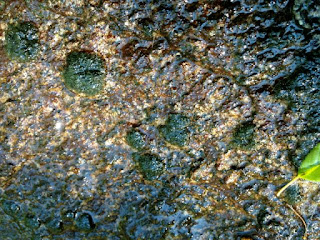I have to confess, when I saw "Cedar Glade" as the title of the SAPS program, I didn't have a clue what it meant. I had no inkling what a unique treat we were in for. Yes, it was a more challenging hike than anticipated; really more of a bushwhack adventure, but when Mother Nature goes to the trouble of creating something so unusual, it stands to reason that one has to work a bit to get there!
Since the ratio of expert to novice was decidedly tipped in favor of the experts, here are some of their comments.
"Cedar Cliff, often referred to as Montane Red Cedar-Hardwood Woodland is one of the more unique rock outcrop communities in the Southern Appalachians. While the Granite Dome Communities are also unique for the region, Cedar Cliff is different in that the type of plants present not only contain some of the usual outcrop species, such as pines, hickories, oaks, grasses, etc. that occur on acidic granitic outcrops but additional more base-loving plants like shooting star, nine-bark, and more abundant red cedar and white ash (see Schafley 2012). When asked what the source of the more basic soils that occur here, Ed Schwartzman stated geologists had not agreed on how the composition of these mafic outcrops relates to the types of minerals making up the rocks from which they form. Ed and Brent pointed out that these more basic soils support abundance of poison ivy and indeed we spent some effort skirting large patches of them. Often these communities support populations of little blue stem, Michaux saxifrage, and a couple of the plants I noted were the dwarf rhizomatous coastal-plain serviceberry, far from its main population distribution, and southern spring beauty, not as common as our Carolina spring beauty."J. Dan Pittillo
Schafley, Michael P. 2012. Available on internet at
"I’ve always enjoyed the tenacity of those cedars hanging on in that bare and thin environment. They cling to those cliffs where very few other tree species can. They take on interesting growth patterns in that harsh world, stunted and even bonsai in appearance as a result. I also like being in a unique plant community that is so hard to get to –" Brent Martin
 "I thoroughly enjoyed the trip with Brent and Ed. It was very interesting to explore the cedar glade which was complete with seeps and some rare species. We got a close look at Sullivan's golden-mane moss as we held onto the branches on which it grew to help us up the steep mountainside. We carefully traversed the wet areas of rock that were adorned with Michaux's saxifrage. American hop hornbeam grew in the forest surrounding the glade. Ed taught us many plants common to such rocky areas including Beadle's mountainmint and shining wedgegrass. Weathered and stunted Eastern red cedars lined the mid-elevation outcrop and were interspersed with Biltmore ash, fringe tree, and fragrant sumac. With Dan Pitillo and Patricia Kyritsi Howell with us we were able to identify and learn about the medicinal uses of many of the plants we saw. We searched for divided-leaf ragwort, a Southern Appalachian endemic, and learned how to distinguish it from the common Small's ragwort. Lunch was enjoyed in the company of hairy-lip fern, a chestnut-sided warbler, and serene views of the surrounding mountains. Ed guided those who were willing up a steep slope from there to see the rare cliff stonecrop. I was delighted to see this tiny plant and to be with such a great group of people!"
"I thoroughly enjoyed the trip with Brent and Ed. It was very interesting to explore the cedar glade which was complete with seeps and some rare species. We got a close look at Sullivan's golden-mane moss as we held onto the branches on which it grew to help us up the steep mountainside. We carefully traversed the wet areas of rock that were adorned with Michaux's saxifrage. American hop hornbeam grew in the forest surrounding the glade. Ed taught us many plants common to such rocky areas including Beadle's mountainmint and shining wedgegrass. Weathered and stunted Eastern red cedars lined the mid-elevation outcrop and were interspersed with Biltmore ash, fringe tree, and fragrant sumac. With Dan Pitillo and Patricia Kyritsi Howell with us we were able to identify and learn about the medicinal uses of many of the plants we saw. We searched for divided-leaf ragwort, a Southern Appalachian endemic, and learned how to distinguish it from the common Small's ragwort. Lunch was enjoyed in the company of hairy-lip fern, a chestnut-sided warbler, and serene views of the surrounding mountains. Ed guided those who were willing up a steep slope from there to see the rare cliff stonecrop. I was delighted to see this tiny plant and to be with such a great group of people!"
-Carrie Radcliffe
"It was great to see the Packera millifolium, which is rare. The more common Packera is used for the female reproductive system. The Rhus aromatica was cool, though just budding. It has a lot of uses.
Was smoked by the Cherokee (red leaves in the fall) and the root bark was also used as an astringent."
Patricia Kyritsi Howell


"The glade itself is of interest as it a rare natural community. The two most significant other features are the sedum glaucophyllum and the sullivants golden mane moss (macrocoma sullivantii)."
Ed Schwartzman
 |
| sedum glaucophyllum--rare cliff stonecrop |
 |
American Columbo (Frasera caroliniensis Walter)
|
 |
Pigeon Wheat Moss
|
 |
Divided-Leaf Ragwort
|
 |
Michaux's Saxifrage
|
 |
Hairy-Lip Fern
|
 |
| Rock Shag Lichen |
 |
| Resurrection Fern |
Compiled by Kathy Stilwell



















No comments:
Post a Comment